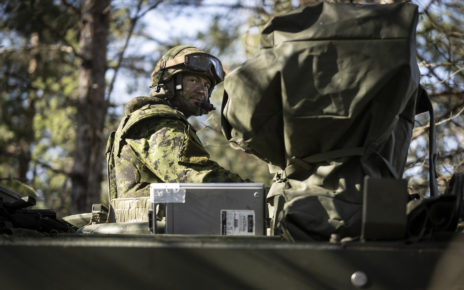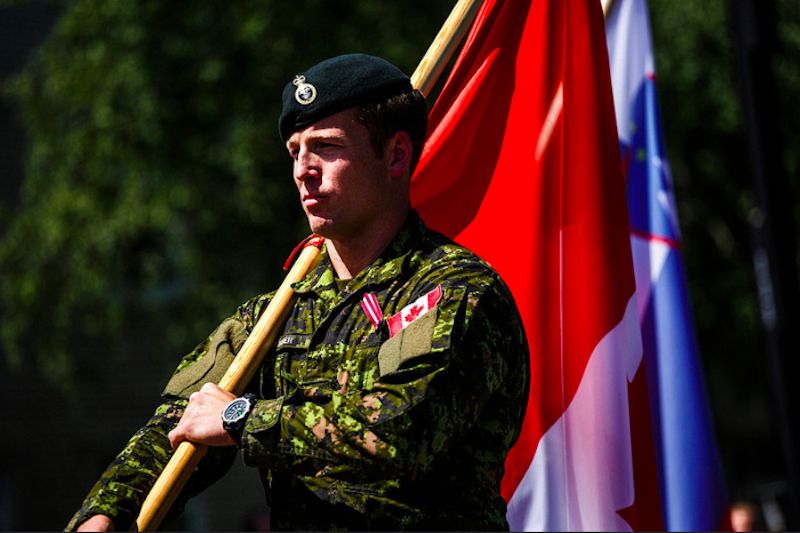Following the annexation of Crimea, and Russia’s generally more aggressive stance in Eastern Europe, tensions between the West and Russia have raised the spectre of a return to Cold-War style confrontation.
Aware of the weaknesses on its Eastern flank, the Alliance decided to bolster its defence. However, wanting to adhere to its 1997 commitment not to permanently station substantial combat forces in Eastern Europe, NATO declined Eastern countries’ requests for large bases in order to not “provoke” the Kremlin. The enhanced presence in Eastern Europe is thus described as “persistent”, not “permanent”.
This process began at the 2014 Wales Summit, when NATO agreed on the Readiness Action Plan (RAP). The so-called “assurance measures” to reassure Central and Eastern European allies comprise of a series of land, sea and air activities in, on, and around NATO’s Eastern flank (including above the Baltic, the Black, and Mediterranean seas). These activities are reinforced by exercises focused on collective defence and crisis management.
In June 2015, NATO defence ministers decided to increase the strength of the NATO Response Force (NRF) from 13,000 to 40,000 troops. As a part of the NRF, they also created the Very High Readiness Joint Task Force (VJTF) as a “spearhead force” in case of Russian aggression against an ally. At its core is a multinational brigade (about 5,000 troops) ready to move quickly, before a crisis begins, and send a strong message of military engagement from all 29 NATO allies. This move symbolizes a return to a deterrence posture, based on Article 5.
In September 2015, eight small, new headquarters, known as NATO Force Integration Units (NFIU), were inaugurated in Bulgaria, Estonia, Latvia, Lithuania, Poland, Romania, Hungary and Slovakia. The NFIUs are of fundamental importance. By connecting these countries’ national forces to those of other NATO members, the units considerably facilitate the latter’s smooth deployment to the Eastern part of the Alliance, benefit collective defence planning, and expedite joint training and exercises. In addition, in December 2015, a Multinational Division Southeast Headquarters (HQ MND-SE) was inaugurated in Bucharest, Romania. With its 280 personnel, the HQ MND-SE exerts command and control over the NFIUs and the forces deployed within the Southeast region. Furthermore, the Alliance’s defence ministers reiterated their commitment to an “enhanced forward presence” (EFP) in February 2016. This was a reaffirmation of the group’s 2014/15 efforts to reassure their Eastern allies and partners.
Later in 2016, NATO announced its intention to deploy four rotational battalions (around 1,000 troops per battalion) to Estonia, Latvia, Lithuania and Poland, led by the United Kingdom, Canada, Germany and the United States respectively. The purpose, as NATO Secretary General Jens Stoltenberg clarified before the June 2016 meeting with the Alliance’s defence ministers, was to “send a clear signal that NATO stands ready to defend any ally” and demonstrate the enduring strength of the transatlantic bond, and the commitment and cohesion of the Alliance. The deployment was formally approved at the NATO summit in Warsaw in July 2016.
In response to Russia’s renewed bellicosity, and firmly encouraged by the United States, the European allies and Canada also decided to increase their defence spending, in an attempt to reverse the long decline that followed the end of the Cold War. In September 2014, the Allies decided at the Wales Summit to make the recommendation of the 2% GDP spending an obligation. However, according to the NATO Secretary General’s Annual Report from March 2017, only five members (the US with 3.61%, Greece with 2.36%, Estonia with 2.18%, the UK with 2.17% and Poland with 2.1%) met the 2% spending target last year. Canada, a founding member of NATO, is currently ranked 6th (behind the US, France, the UK, Germany and Italy) in terms of contribution to NATO’s budget.
According to Stoltenberg’s report, Ottawa’s defence spending saw a small increase in 2016, pushing the percentage of its GDP defence spending from 0.98% up to 1.02%. But this is still the smallest share of GDP that Canada has spent on defence since 2012 (only Belgium, the Czech Republic, Iceland, Luxembourg and Spain spent less).
However, recent claims by the Canadian government suggest that Ottawa is planning to reach 1.4% by 2024-25. This past June, Canadian Minister of Defence Harjit Sajjan announced Ottawa’s intention to boost its defence budget by 70% (CAD 24.2 billion) in the next decade. The money will primarily be invested in new military acquisitions and technologies that will allow the Canadian military to conduct cyber attacks, unmanned airstrikes, and buy some 88 fighter jets and 15 warships. The announcement followed Minister of Foreign Affairs Chrystia Freeland’s dramatic speech about a US retreat from the world stage and a need for Canada to “strive for leadership”. President Trump did not formally confirm his commitment to Article 5 at the NATO Summit in Brussels, and there is increasing concern among NATO allies about the role that the US will play in the Alliance during Trump’s tenure.
The defence spending increase will not be immediate, as it is not expected to start until 2019, after the next elections take place. However, this sends a clear message to the Allies that Canada is willing to do more and is committed to European defence, even in the event that the US decides to back off. In the last few months, following pressure by the new US administration for allies to reach the 2% GDP threshold, Prime Minister Justin Trudeau had already defended Canada’s role in the Alliance by emphasizing its military contributions to NATO missions.
The Canadian Armed Forces (CAF) have, in fact, been a major contributor to NATO operations and exercises since the founding of the Alliance 68 years ago. Since 2014, Canada has been supporting NATO assurance and deterrence measures in Central and Eastern Europe by contributing personnel under Operation REASSURANCE. As part of this operation, the CAF have been leading an EFP battlegroup in Latvia. The battlegroup is led by Canadian Lieutenant-Colonel Wade Rutland and comprises military personnel from Albania, Canada, Italy, Poland, Slovenia, and Spain. Canada is contributing over 455 personnel, including a headquarters element, a mechanized infantry company, combat service support, vehicles, and equipment based at Camp Adazi (East of Riga).
The Canadian military has also deployed troops to Poland and is in charge of Operation UNIFIER, a multinational joint task force to Ukraine made up of Canada, the United States and the United Kingdom. About 200 CAF members are currently stationed in the country, and will stay there until March 2019, in an attempt to promote security in the region through capacity building and the training of the Ukrainian Armed Forces. At present, the operation is led by Canadian Lieutenant-Colonel Kristopher Reeves and, as of September 2017, has trained over 5,500 Ukrainian soldiers.
The assets deployed under Operations Reassurance and Unifier clearly underscore the Canadian government’s enduring commitment to NATO and its determination to do what it takes to defend European allies against potential Russian aggression, safeguard security, and ensure stability in the Euro-Atlantic area.
To this end, Canada also recently took part in Exercise FORMIDABLE SHIELD, a major NATO air and missile defence exercise conducted at the Hebrides Range in the Western isles off Scotland. The exercise, which took place from 24 September to 18 October, involved 14 ships, 10 aircraft and around 3,300 personnel from Canada, France, Germany, Italy, the Netherlands, Spain, the UK and the US. It aimed to strengthen cooperation between NATO allies in the face of potential missile threats, and was in line with NATO’s 2010 decision to develop a capability to defend European allies against ballistic missile threats.
Although some analysts and institutions seem to question the CAF’s actual chances of success in the event of a full-scale Russian attack in Central and Eastern Europe, the NATO presence, and Canada’s in particular, is warmly welcomed by the local population and government. According to a 2016 poll commissioned by the Latvian Ministry of Defence, over 40% of residents approve of the battalion’s presence. Therefore, by stepping up efforts Canada is making a profound difference for European allies at a time when America’s longstanding commitment to NATO and European security appears to be uncertain.
Photo: Colonel Victor Kopachinskiy, Commander of the 80th Airmobile Regiment, along with Captain Robert Colbourne and Lieutenant Colonel Roch Pelletier, Commander of 3rd Battalion, Royal 22e Régiment, address C Company after a parachute landing during Exercise Rapid Trident (2011), by Corporal Jax Kennedy, Canadian Forces via Wikipedia Commons. Licensed under CC 2.0.
Disclaimer: Any views or opinions expressed in articles are solely those of the authors and do not necessarily represent the views of the NATO Association of Canada.




